The inclusion of fresh herbs in this Panmarino Italian Rosemary Bread provides an earthy characteristic and an intoxicating fragrance. When you add olive oil to the mix, it blends the elements together to form the perfect environment for a savory meal.
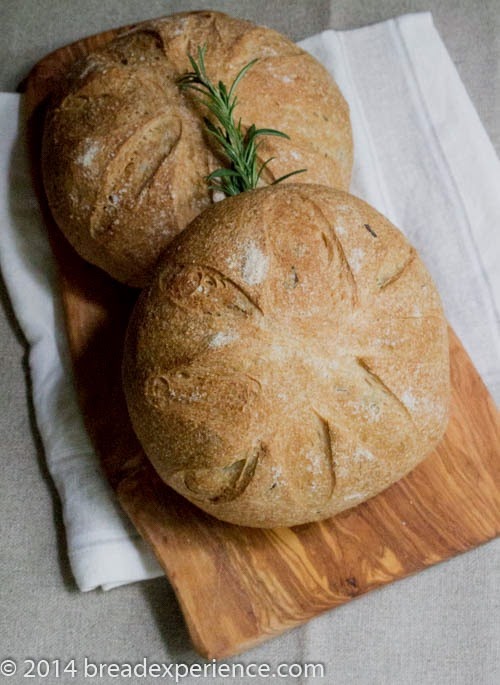
I particularly enjoy making breads with rosemary. As the bread is baking, the aroma of the herbs drifts out of the kitchen and follows me around the house until I succumb to it’s invitation.
It was this experience I was thinking about when I selected the monthly bread for the Bread Baking Babes. I’m the host kitchen so I wanted to present a bread that was simple, yet full of flavor and one would go well with a variety of foods. I chose the Italian Rosemary Bread called Panmarino.
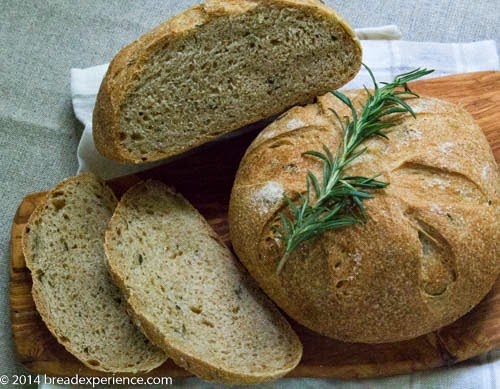
Panmarino is unique in it’s simplicity, but also in it’s history. Legend has it that it originated in the area called Ferrara, near Venice and was created by a baker named Luciano Pancalde.
The idea for Panmarino came about as Luciano was reading the chronicles of the d’Este family who once ruled Ferrara. When he learned about the magnificent court banquets where they served rosemary bread with a crust that “sparkled with diamonds,” it gave him the idea to create his own loaf. He experimented and baked and tested some more until finally, he had the bread he was aiming for, an aromatic, dome-shaped bread that is scored in the pattern of a star and sprinkled with salt crystals.
Panmarino is a delightful loaf. If you are looking for a fragrant loaf that utilizes the freshest of ingredients, this is the loaf for you.
Don’t confuse simplicity with lack of taste or method. This is a fairly easy bread to make, but it takes about 20 hours from start-to-finish. Most of that time is spent on the overnight biga so the hands on time is minimal.
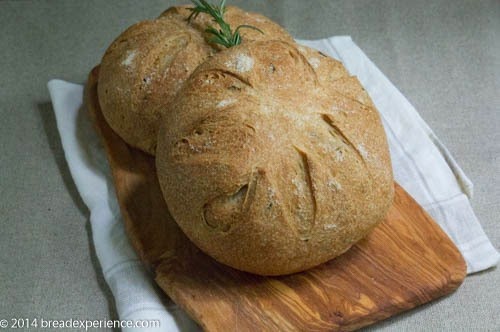
The source of the story about the origins of Panmarino is found here
These loaves are charmingly small and make great companions for an evening meal. I made two loaves and gave one away. If you look closely in the photo above, you can just barely see the diamonds (sprinkles of salt) in the slashes.
The original formula made four loaves. I reduced it two loaves. I did the calculations based on baker’s percentages, but you can halve everything and it should be fine.
I used sifted white whole wheat flour instead of bread flour in the final dough because I’m experimenting with home-milled flours, but feel free to use bread flour or regular all-purpose or spelt flour to make this bread.
Panmarino Italian Rosemary Bread
Adapted from The Fundamental Techniques of Classic Bread Baking from The French Culinary Institute.
Adapted Formula (makes 2 loaves)
Biga
- 71g (~1/2 cup) bread flour
- 60g (scant 1/4 cup) water
- pinch instant yeast
Final Dough:
- 442g (~3 1/2 cups) bread flour *
- 240g (1 cup) water
- 22g (2 T) milk
- pinch instant yeast
- 44g (1/4 cup) olive oil
- 4g (2 T) rosemary
- Biga, all
- 11.5g (~ 3 tsp.) salt **
* I started with 568g of whole wheat. After I sifted out the bran, I ended up with 472g so I had a little extra for sprinkling, if necessary.
** Some of the other bakers thought this was too much salt. Feel free to reduce the amount of salt to suit your tastes.
Original formula (makes 4 Loaves)
Biga:
- Bread flour 143 grams/5 ounces
- Water 122 grams/4 1/4 ounces
- Pinch of instant yeast
Final Dough:
- Bread flour 884 grams/1 pound 15 ounces
- Water 477 grams/1 pound 1 ounce
- Milk 44 grams/1 1/2 ounces
- Biga 265 grams/9 1/3 ounces
- Salt 23 grams/3/4 ounce
- Pinch of instant yeast
- Olive oil 88 grams/3 ounces
- Chopped fresh rosemary 9 grams/1/3 ounce
Baker’s Percentages:
Biga (185.1% total)
- Bread flour 100%
- Water 85%
- Fresh yeast 0.1%
Final Dough (203.6% total)
- Bread flour 100%
- Water 54%
- Milk 5%
- Biga 30%
- Salt 2.6%
- Fresh yeast 1%
- Olive Oil 10%
- Chopped fresh rosemary 1%
Prepare the Biga:
Combine the flour, water and yeast in a mixing bowl. Stir with a wooden spoon or Danish dough whisk until well blended. Scrape down the bowl, cover with plastic wrap, and let it rest at 75 degrees F. for 14 to 16 hours.
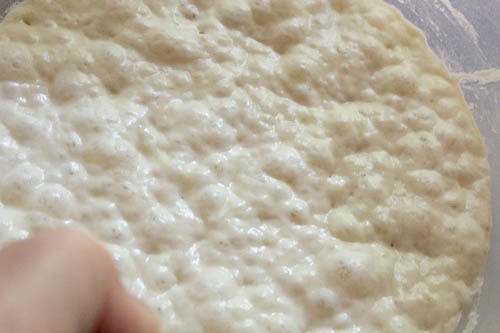
Making the Final Dough:
Combine the flour, water, milk, and biga in the bowl of a stand mixer. Using the dough hook, mix on low speed until blended.
Add the salt and yeast and mix on low speed for 5 minutes. Increase the speed to medium and mix for about 7 more minutes, or until the dough is smooth. When the gluten is fully developed, mix in the olive oil and rosemary on low speed.
Lightly oil a large bowl. Scrape the dough into the bowl and cover with plastic wrap. Let the dough ferment for 45 minutes.
Remove the dough to a lightly-floured work surface and divide it into four (or two if you halved the recipe) 450-gram /16-ounce pieces. Shape the dough pieces into rounds. Cover with plastic wrap and let them bench rest for 15 minutes.
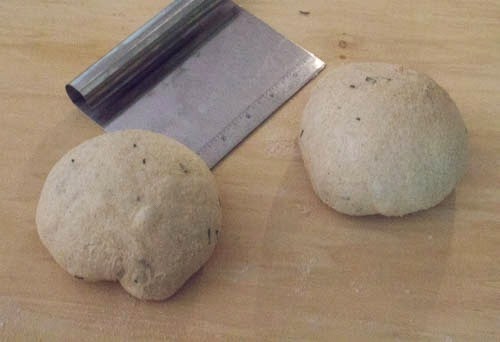
Place two couches on a separate work surface or bread board and dust them with flour.
Uncover the dough and, if necessary, lightly flour the work surface. Gently press on the dough to degas and carefully shape each piece into a tight and neat rounds. Place one loaf on one side of the couche, fold the couche up to make a double layer of cloth to serve as a divider between the loaves, and place a second loaf next to the fold. Repeat the process with the remaining two loaves and the second couche. Cover with plastic wrap and proof for 1 hour.
I proofed the loaves on cornmeal-dusted parchment paper instead of a baker’s couche. I baked the loaves on the parchment paper on a preheated baking stone and used a cast iron skillet on the top shelf as the steam pan. You can proof the loaves in a proofing basket if you prefer.
About an hour before you plan to bake the loaves, place a baking stone (or tiles) into the oven along with a steam pan (underneath) or iron skillet (on the top rack) and preheat the oven to 450 degrees F.
Uncover the dough and score the top of each loaf in a star pattern using a lame or sharp knife.
Optional: sprinkle sea salt into the crevices as the original baker did to make it “sparkle with diamonds.”
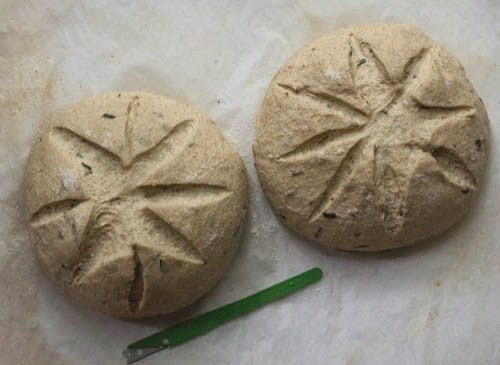
Carefully transfer the loaves (on the parchment paper) to the preheated baking stone using a peel or the back of a baking sheet. To make the steam, add 1 cup of ice to the iron skillet or steam pan.
Bake for 40 minutes, or until the crust is light brown and crisp and the loaves make a hollow sound when tapped on the bottom.
Remove the loaves from the oven and transfer to a wire rack to cool.
I sent these loaves to be yeastspotted.
These are easy and pleasant loaves for summer baking. I think you’ll enjoy them.
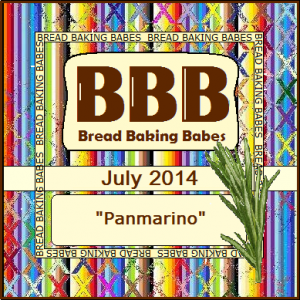
Check out how the other creative Babes handled this bread:
The Bread Baking Babes (current dozen) are:
- Bake My Day – Karen
- blog from OUR kitchen – Elizabeth
- Bread Experience – Cathy
- Feeding my Enthusiasms – Pat/Elle
- girlichef – Heather
- Life’s a Feast – Jamie
- Living in the Kitchen with Puppies – Natashya
- Lucullian Delights – Ilva
- My Diverse Kitchen – Aparna
- My Kitchen In Half Cups – Tanna
- Notitie Van Lien – Lien
- Thyme for Cooking – Katie (Bitchin’ Bread Baking Babe Bibliothécaire)
Happy Baking!
Cathy
ilva says
I love this bread, well the whole family does and I will definitely make it again!
Cathy W. says
So glad you enjoyed it Ilva!
Renee Goerger says
Such a beautiful star burst design you created on top of your loaves. Also thanks for adapting this recipe for only 2 loaves. I think that’s what I’m going to do. Lovely recipe, Karen. Can’t wait to try this!
Renee – Kudos Kitchen
Cathy W. says
Thanks Renee! I hope you enjoy it as much as I did.
MyKitchenInHalfCups says
Yes, well the hands on time may be minimal unless you decide to let the stand mixer sit idle and knead by hand. It’s been a long time since I spent more time and more of a work out kneading than with this bread. I’m not complaining because I really love to feel the changes in the dough and I find it relaxing … then I sort of fool myself into thinking it’s such a work out I’m entitled to another slice.
Don’t know why I thought two slashes would make a star. Four would be perfect.
Thanks much for this one, I too adore rosemary in bread.
Cathy W. says
Okay, okay. So you should thank me for the workout. I think I made one too many slashes. Probably three would be perfect although I do like the way these loaves turned out.
Lien says
Thanks for this wonderful recipe, I love the rosemary in it. What a treat to have been able to visit plate to page in Tuscany itself!!
Cathy W. says
I’m so glad you enjoyed it. Yes, it was definitely a treat to go to Tuscany and participate in the Plated Stories workshop.
Elizabeth says
Many thanks for choosing this recipe, Cathy! We loved it!
Your bread, of course, looks stunningly beautiful. It’s brilliant that the slashes remained so well defined.
Cathy W. says
Thank you Elizabeth! I’m so glad you enjoyed it. The scoring is hit or miss with me sometimes. This one hit the mark.
Elle says
Love your four slash stars…very beautiful when baked. Thanks for choosing such a delightful bread Cathy. Will make this one again.
MyKitchenInHalfCups says
In this case, I think your “extra” slash was exactly perfect.
Katie Zeller says
I’m not quite sure how to say this….. But you slash very well. (I wanted to say it another way, but one does have to be careful….) I’m living vicariously through travels and baking – end enjoying it all 😉
Roberto says
Hello Cathy
Could you please share the Baker’s Percentage formula for Panmarino?
Thank you
Cathy says
Hi Roberto, here are the percentages for the original formula. I edited the post to include this info.
Biga (185.1% total)
Bread flour 100%
Water 85%
Fresh yeast 0.1%
Final Dough (203.6% total)
Bread flour 100%
Water 54%
Milk 5%
Biga 30%
Salt 2.6%
Fresh yeast 1%
Olive Oil 10%
Chopped fresh rosemary 1%